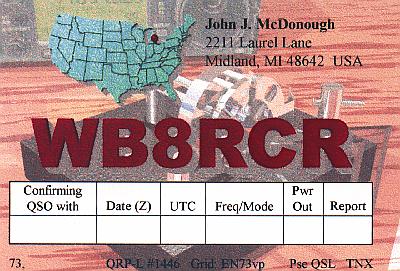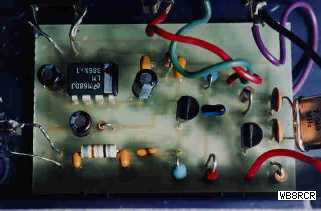
| Station | I hold the amateur radio license WB8RCR and enjoy operating CW, experimenting with
hardware and software, and the general technical challenge of the hobby, to say nothing
of the fun of meeting new people.
I frequently operate QRP, which is amateur jargon for low power. There is great challenge in contacting other amateurs all over the world with minimal resources. Most frequently you can find me at 14.060 MHz, which is the low power calling frequency on the amateur 20 meter band.
|
|---|---|
| Antennas | I often experiment with different antennas. I wrote a little antenna
calculator to help, which used to be on this page.
Unfortunately, due to a clueless, activist judge, it appears that it is no longer legal to have this sort of thing on the web(!) There will probably be some workaraounds discovered in the future, but for now, the applet has been removed.
|
| QSLs | Amateurs trade reports of their contacts by mail in the form of QSL cards. Many
amateurs have their cards professionally printed, but more and more people are using
their computers to make their own cards. Here's a scan of my computer-generated
card:
Recently, a conversation on an internet mailing list about amateur radio prompted me to begin working on a program to make it easier to compose QSL cards. The HFradio site where QSLmaker is kept is currently down. If you are looking for the download, this link provides the current release, zip file only.
|
| QRPp |
One of the very fun things hams sometimes try to do is establish
communications using the least possible resources, whether that
be size, weight, power, or antennas. A popular transceiver for
this purpose is the Pixie II, which has undergone endless
experimentation and modification. This little radio is powered
by a 9 volt battery (typically) and is traditionally housed in an
Altoids tin! Here's a picture of mine before I remounted it in
the obligitory Altoids tin:
 On a similar vein, the NJ QRP Club came out with a 40 milliwatt transmitter, the FireBall 40. Of course, I had to try one of those. Here's a peek at my efforts, complete with the obligatory Altoids tin. Also on the homebrew side, but a little beefier, take a peek at my 2N2/40, a full blown 40 meter CW rig. And yet another little homebrew project, if not exactly QRP, a tune control for the Icom 706. Recently I finished up a NorCal NC-20 kit. OK, as a kit it's not really homebrew, but it was a fun exercise. Pictures and prose here! April 29 2000- QRPTTF. For the first time, I decided to go to the field and operate this contest. Fun, but not much of a showing. But see the pix anyway! The QRPTTF pictures from 2001 are on the way. Well, Norcal just can't quit with this making great kits that a guy just can't resist, whether he needs yet another 40 meter righ or not. This time it's the SMK-1, a surface-mount rascal. Take a peek. A lot of projects these days make use of Microchip's PIC microcontroller. Here's a peek at a little programmer for the PIC. Also a counter and a Morse decoder. I also recently built up an AD9850 based VFO which is driven by a PIC. And my most recent kit-built rig, an Elecraft K1. There are alll sorts of great QRP conferences. In 2004, I got to go to Atlanticon for the first time, and even presented a paper there. Great fun. Here are the pictures.
|
| Traffic |
I have become fairly involved in traffic handling of late. In 2003 I was
named Assistant Section Traffic Manager for Michigan, and at the state
convention, was awarded my ORS certificate.
One net I particularly enjoy is QMN, the Michigan Net. This is a CW net, and is the oldest spot frequency net in the nation. Each year they hold a picnic, and here are the pictures from the 2003 event. I've also been looking at how can we improve the National Traffic System. K8CQF, the STM, VE3EUI, another Assistant STM, and myself presented a fairly lengthy paper on the topic to the ARRL. Here is a link to some of my research for that paper.
|
| Blogs |
I do a fair bit of blogging over on multiply. These blogs cover the
gamut, and unfortunately, multiply doesn't make it easy to pick out
the interesting ones, especially if you aren't a member. So for
ham radio and technical topics, I've put together a small site
that contains those of my rants associated with amateur radio.
|
| Links | The following are some interesting ham radio related links:
|
22 Apr 2012